In the footsteps of Robin Hood FEATURE
He robbed from the rich and gave to the poor, so legend has it. No-one can tell who the English folklore legend Robin Hood really was, but in the city of Nottingham the fascinating story of the famous archer continues to attract tourists wishing to find out more about this elusive hero.
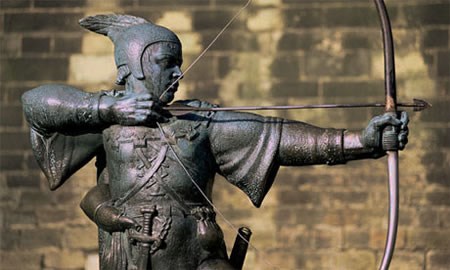
Robin Hood is one of the most well-known figures in history, and most of us are familiar with the legend, as told in dozens of films and television programs.
Robin of course, is usually depicted as dressed in a distinctive green outfit, and along with his band of Merry Men, is constantly fighting his foe, the evil Sheriff of Nottingham. The outlaw was almost certainly a real person and over the centuries the story has been embellished to become more of a legend.
The first mention of Robin Hood was back in the early 15th century with a rhyme that began, 'Robyn hode in scherewode stod', which along with other medieval references point Robin's true location to South Yorkshire.
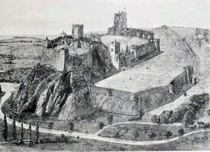 Reconstruction of Nottingham Castle in the late medieval era, illustrated in the Victorian period
Reconstruction of Nottingham Castle in the late medieval era, illustrated in the Victorian periodNobody is entirely sure who Robin was, but if you are visiting the UK and want to follow in Robin's footsteps, there are plenty of places in Britain associated with him.
The Midlands city of Nottingham is the place most associated with Robin, despite the fact that evidence suggests he may have been born elsewhere. The city does have a real Sheriff of Nottingham, although his main duties these days are to promote tourism.
It is the references in the modern versions of the legend that Robin is seen to be in residence in the verdant Sherwood Forest in Nottinghamshire, which is why the city has a particular affinity with him.
Several public buildings, streets and squares are named after Robin Hood and his band of outlaws, although the obvious place to start following in his footsteps is at Nottingham Castle, which enjoys a dramatic setting overlooking the River Trent and the city.
A bronze statue of Robin shooting an arrow is outside the castle entrance and the castle is perched on an outcrop, which is riddled with passages.
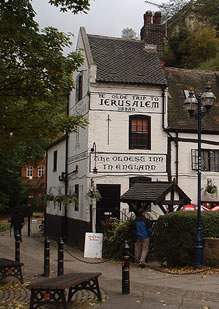 Ye Olde Trip To Jerusalem in Nottingham is one of the oldest pubs in England.
Ye Olde Trip To Jerusalem in Nottingham is one of the oldest pubs in England.Some of these passages are said to lead to the pub situated under the castle, Ye Olde Trip to Jerusalem, one of the oldest in England. The pub is supposedly named for the times when men would stop here on their way to the crusades in the Middle East, and today it serves traditional British food and excellent local beer. As the inn dates back to 1189, it isquite likely that Robin and his outlaws enjoyed a few drinks here while plotting their next move.
Several other sites in the city have associations with Robin. St. Mary's Church is the largest medieval building in Nottingham and in addition to its huge doors with their advanced locking mechanism, it also featured in early ballads about Robin Hood. Shire Hall was once the Sheriff's home and today is home to the Galleries of Justice Museum, as well as one of England's most active ghosts. Indeed, it is claimed that it has the most active poltergeist in the UK, and many visitors have said that they have been touched, or even attacked by invisible forces in the medieval dungeons below the Shire Hall.
If you visit Nottingham during October, you can experience the city's Robin Hood pageant, which features crafts from the period, jousting and archery. For a couple of days, the grounds of the castle are transformed into a medieval village and it is easy to imagine yourself back in the 12th century.
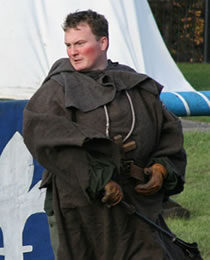 The Robin Hood Pageant is held each year at Nottingham Castle. Picture by RobinHood.org.uk (with more information about the event)
The Robin Hood Pageant is held each year at Nottingham Castle. Picture by RobinHood.org.uk (with more information about the event)The outlaws hid from their enemies in the huge and sprawling Sherwood Forest, which is still there today, but covers only around 400 acres, instead of the thousands that it did in the 12th century. A visitors' centre has a small exhibition depicting what life might have been like for Robin and his Merry Men, living in the forest.
Sherwood Forest is also home to a huge oak tree which measures over 30 feet around, and has become known as Robin Hood's Tree, or the Major Oak. The tree has been estimated to be at least 800 years old, so it is certainly possible that Robin Hood was around at the time and may have taken shelter under its branches. In 2002, it was voted Britain's favorite tree.
On the edge of Sherwood Forest is the small village of Edwinstowe, where the most picturesquepart of the forest is located. Legend has it that Robin and Marian tied the knot in the parish Church of St. Mary's, which dates from the late 12th century, and there is a statue of Robin proposing to Marian in the village.
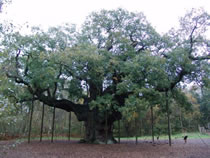 Robin Hood's Oak Tree, located near Newstead Abbey in Sherwood Forest
Robin Hood's Oak Tree, located near Newstead Abbey in Sherwood ForestTwo of the most famous members of Robin's band of outlaws are also said to beburied in the area.Will Scarlett is laid to rest in the village of Blidworth and Little John's grave is in the nearby village of Hathersage.
Robin himself is reputedly buried at Kirkless Priory, situated between Brighouse and Mirfield in Yorkshire, although that has never been proven. It is said that before Robin dies, he asked Little John to bury his body wherever the arrow he shot from the Priory landed, and his grave can be visited on organised walks run by Calderdale Council Tourist Information Centre.
Regardless, travelling in the footsteps of the famous outlaw allows you the chance to experience some of England's fascinating history and architectural wonders.

 Popular
Popular Recent
Recent Comments
Comments



















 Jeff Dunham: Seriously!? Comedy Icon Announces UK Arena Tour for 2020
Jeff Dunham: Seriously!? Comedy Icon Announces UK Arena Tour for 2020
 odome set to revolutionise event marketing
odome set to revolutionise event marketing
 Edinburgh Cocktail Week
Edinburgh Cocktail Week
 Calvin Harris new album 18 Months
Calvin Harris new album 18 Months






